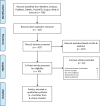Use of active video games with or without videoconferencing on health outcomes in adolescent and young adult cancer survivors: a systematic review
- PMID: 34086184
- PMCID: PMC8175926
- DOI: 10.1007/s11764-021-01065-z
Use of active video games with or without videoconferencing on health outcomes in adolescent and young adult cancer survivors: a systematic review
Abstract
Purpose: Adolescent and young adult (AYA) cancer survivors experience greater functional deficits compared to non-cancer peers or older survivors with a similar diagnosis. Physical activity (PA) is a key strategy for mitigating functional decline, and motivation and peer support are critical PA facilitators in AYA cancer survivors. Active video games (AVGs) may be a "gateway" method to promote PA. Further, integrating AVGs into group videoconferencing, a medium used by AYAs to socialize, can capitalize on peer support needed for PA motivation. Thus, we examined the use of AVGs and/or videoconferencing in PA interventions that included AYA survivors and the effect on physical function and health outcomes.
Methods: Seven electronic databases were searched from incept to January 2020. Search terms included videoconferencing, video games, exercise, and cancer. The protocol is registered on PROSPERO: CRD42020163491. Two reviewers evaluated eligibility and methodological quality using Cochrane's risk of bias tools.
Results: Six unique studies were included with 97% reviewer agreement. All used AVGs, none used videoconferencing alone, and one used both. Study designs and outcome measures were heterogeneous. Only one study solely targeted AYA survivors. Most were low to medium quality. Few showed significant improvements in quality of life (QOL) and fatigue (n=3), coordination/balance (n=2), and aerobic capacity (n=1).
Conclusions: PA interventions using AVGs and/or videoconferencing may improve QOL and fatigue, but evidence on function is lacking. Rigorous interventions targeting AYA survivors are needed.
Implications for cancer survivors: Using AVGs and/or videoconferencing to facilitate PA may improve QOL and fatigue.
Keywords: Active video games; Adolescent and young adult; Cancer; Physical function; Systematic review.
© 2021. The Author(s), under exclusive licence to Springer Science+Business Media, LLC, part of Springer Nature.
Conflict of interest statement
The authors declare no competing interests.
Figures
References
-
- Adolescent and Young Adult Oncology Progress Review Group . Closing the gap: research and care imperatives for adolescents and young adults with cancer. Bethesda: National Cancer Institute, National Institutes of Health, and the LIVESTRONG Young Adult Alliance; 2006.
-
- American Cancer Society . Cancer facts & figures. Atlanta: American Cancer Society; 2020. pp. 29–43.
Publication types
MeSH terms
Grants and funding
LinkOut - more resources
Full Text Sources
Medical


